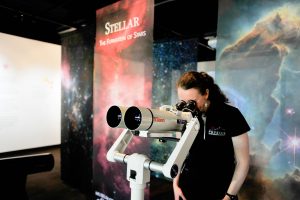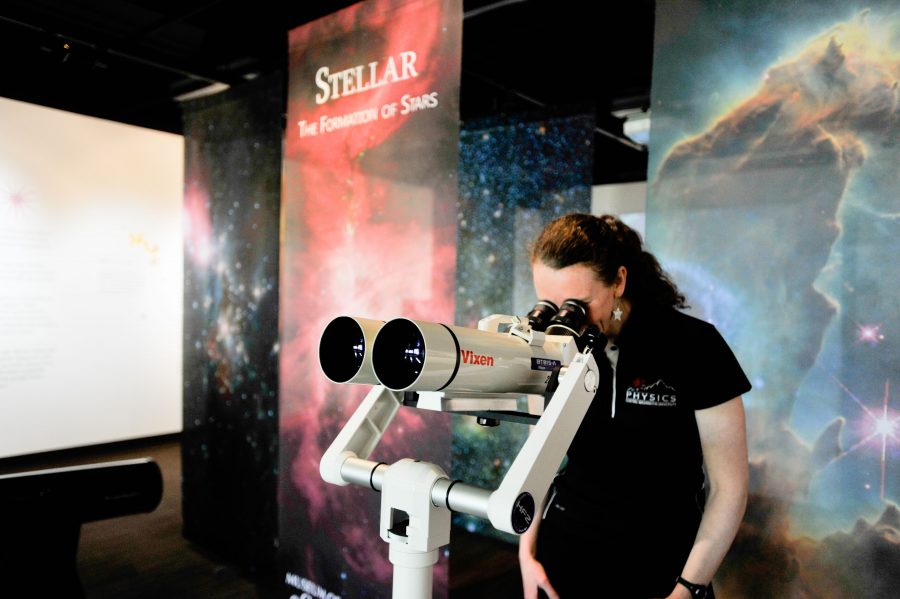A stellar exhibit
The Museum of Culture and Environment opened up its new exhibit “Stellar: The Formation of Stars”
April 13, 2017
 Xander Fu
Xander Fu
Long translucent cloth decorated with pieces of the galaxy stretch from the ceiling to the floor in the CWU Museum of Culture and Environment. Behind the sheets, pictures of the Helix Nebula, Twin Jet and many other photos of space are displayed on the walls.
A telescope faces the upper part of the opposing wall at a small picture of the galaxy. Viewers who look through the glass will see a magnified version of the galaxy and get a small surprise that is not visible to the human eye.
The “Stellar: The Formation of Stars” exhibit in the Dean Hall museum opened April 6 at 5:30 p.m. at an opening presentation. Lynn Bethke, collections manager for the museum, was the main designer of the new space exhibit.
Bethke’s goal for the exhibit is to inspire people with the awe and wonder of nebulas so that they will be enticed into learning more and reading about them after visiting the museum. She was able to use natural beauty and science to present the star exhibit in a unique way.
The walls lining the nebulas display contain information on the formation of stars and a chart of how different waves—micro, radio, magnetic and others—look on the back wall. More pictures and the names of specific galaxies and stars decorate the right side of the wall, while the “The Things We Carry” display is on the other side. “The Things We Carry” display contains several objects including a pair of cowboy boots.
The guests started to arrive for the opening and were greeted with tall standing tables covered with white tablecloths and center candles. Cheese cubes, veggies, meatballs, and other assortments of food were lined up by the window in classy metal containers for the enjoyment of museum-goers.
Many students were also involved in the building of the exhibit, including Barbara Hammersberg, who organized the food and helped set up the opening event. These students were able to get internship experience by being involved in this particular project.
William Ruefenacht, a third-year biology major who attended the opening, said he felt a little under dressed and thought the event was just for professors when he first walked in.
“It was the first time I had been in there,” Ruefenacht said.
Alex Brockwell, a first-year physics major, was impressed by the food and the quality of the pictures presented in the exhibit.
After the meet and greet, a presentation was given that covered the two main parts of the museum. One was called “The Things We Carry” and described how chimps make sentimental connections to objects they grow familiar with. Demaris Climer, another third-year biology student, found the primate presentation interesting.
“I didn’t know they [chimps] would find objects and have a sentimental connection to it,” Climer said.
Ruefenacht also thought that the chimp presentation was nice to listen to because he is a biology major and it connected with him. He found the chimp part unexpected, but enjoyable.
The second presentation was called “Stellar, the Formation of Stars.” This presentation was given by Cassandra Fallscheer, assistant professor of physics. Her sparkly star earrings highlighted her delight in the subject as she described her research in the electromagnetic process and the many different telescopes used to observe the stars.
Fallscheer is excited to continue her research in the new observatory being built in the Science II building. This observatory will be open for public viewing, and Fallscheer’s search for exo-planets, planets outside our solar system.
“I got some new information on how stars were formed,” Climer said.
Brockwell found the Stellar presentation particularly interesting as he is a physics major. He also found the space pictures presented in the exhibit to be cool.
The space exhibit will be open all of spring quarter and some of it will continue through fall quarter of next year.



